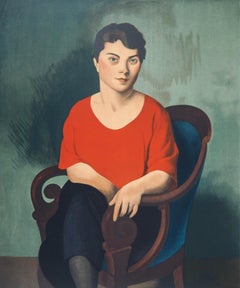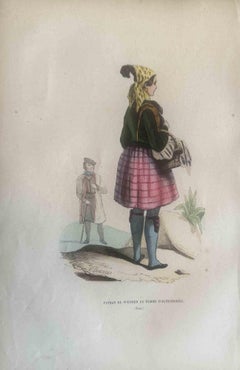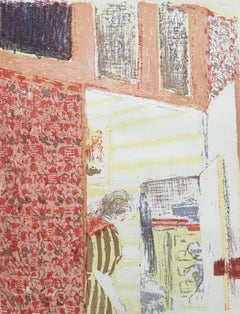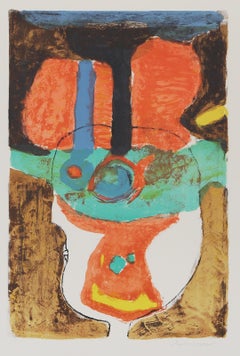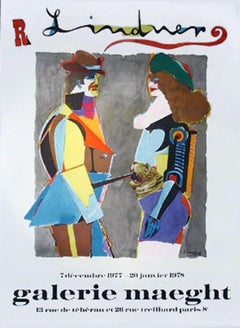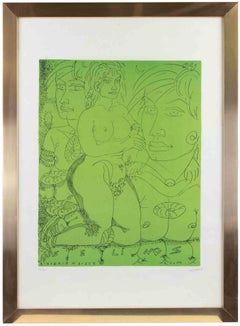Boy Figurative Prints
to
116
245
127
115
52
26
Overall Width
to
Overall Height
to
190
105
34
28
17
14
12
12
6
5
5
4
1
12
12
9
8
4
22
103
349
93
8
14
23
11
9
30
40
77
43
29
18
365
179
19
4,751
26,837
14,688
10,537
9,011
7,712
7,001
4,553
4,133
2,385
2,032
1,924
1,866
1,706
1,470
1,469
1,464
1,453
1,277
1,221
222
132
114
54
37
79
247
248
242
Art Subject: Boy
Roger de La Fresnaye, The Romanian Woman, 1968 (after)
Located in Southampton, NY
This exquisite lithograph after Roger de La Fresnaye (1885–1925), titled La Roumaine (The Romanian Woman), from the album Roger de la Fresnaye, III, Collection Pierre Levy, 1968, ori...
Category
1960s Cubist Figurative Prints
Materials
Lithograph
$716 Sale Price
20% Off
Uses and Customs - Altenbourg - Lithograph - 1862
Located in Roma, IT
Uses and Customs - Altenbourg is a lithograph on paper realized in 1862.
The artwork belongs to the Suite Uses and customs of all the peoples of the universe: " History of the gover...
Category
1860s Modern Figurative Prints
Materials
Lithograph
Vuillard, Intérieur aux tentures roses, L'œuvre gravé de Vuillard (after)
Located in Fairfield, CT
Medium: Lithograph on grand vélin Renage paper
Year: 1948
Paper Size: 12.375 x 9.5 inches; image size: 11.81 x 9.05 inches
Inscription: Unsigned and unnumbered, as issued
Notes: From...
Category
1940s Post-Impressionist Figurative Prints
Materials
Lithograph
$716 Sale Price
20% Off
Modern Portrait, Art Brut Lithograph by Slavko Kopac
Located in Long Island City, NY
Slavko Kopac was born in Croation in 1913. He was one of the founding members and curators of Art Brut (Compagnie de L'Art Brut). 1948, Compagnie de L'Art Brut is founded by Slavko K...
Category
1980s Modern Figurative Prints
Materials
Lithograph
Galerie Maeght, Pop Art Lithograph Poster by Richard Lindner
Located in Long Island City, NY
Richard Lindner, German/American (1901 - 1978) - Galerie Maeght, Year: 1977, Medium: Lithograph Poster, Size: 30 in. x 22 in. (76.2 cm x 55.88 cm)
Category
1970s Pop Art Figurative Prints
Materials
Lithograph
Maselinos Circeria Odissea - Lithograph by Tono Zancanaro - 1970s
Located in Roma, IT
Maselinos circeria odissea is a contemporary artwork realized in 20th century.
Mixed colored lithograph.
Includes frame.
Hand signed and numbered on the lower margin.
Edition of ...
Category
1970s Contemporary Figurative Prints
Materials
Lithograph
Commen en T.S.F. G.M.R. s'Assure la Première Place-Lithograph by G. Pavis -1940s
Located in Roma, IT
Lithograph on paper realized by Alessandro Kokocinski.
Edition of 125 inarab numbers plus 50 in roman numbers.
Hand signed and numbered in pencil.
Excellent condition.
Category
1990s Contemporary Figurative Prints
Materials
Lithograph
Girl and Child - Etching by James Tissot - Late 19th Century
By James Tissot
Located in Roma, IT
Girl and Child is an original Modern artwork realized by James Tissot, in full James-Joseph-Jacques Tissot, (born Oct. 15, 1836, Nantes, France—died Aug. 8, 1902, Buillon Abbey, near...
Category
Late 19th Century Modern Portrait Prints
Materials
Paper, Etching
Jean Cocteau - Jean Monnet's Vision - Original Lithograph
By Jean Cocteau
Located in Collonge Bellerive, Geneve, CH
Original Lithograph by Jean Cocteau
Title: Jean Monnet's Vision
Signed in the stone/printed signature
Dimensions: 33 x 46 cm
Edition: 200
Luxury print edit...
Category
1960s Modern Portrait Prints
Materials
Lithograph
Degas, Le Coucher, E. Degas Monotypes (after)
By Edgar Degas
Located in Fairfield, CT
Medium: Engraving on vélin du Marais paper
Year: 1948
Paper Size: 12.25 x 9.125 inches; image size: 8.625 x 6.375 inches
Inscription: Unsigned and unnumbered, as issued
Notes: From t...
Category
1940s Impressionist Figurative Prints
Materials
Engraving
$716 Sale Price
20% Off
Figure - Original Lithograph - Mid-20th Century
Located in Roma, IT
Figure is an original print in lithograph on paper realized by an anonymous artist of the mid-20th Century.
In very good conditions.
The artwork created through confident strokes, ...
Category
Mid-20th Century Modern Figurative Prints
Materials
Lithograph
Bauhaus by Mychael Barratt, Limited edition print, Bauhaus art, Modernist [2022]
Located in Deddington, GB
Bauhaus by Mychael Barratt [2022]
limited_edition and hand signed by the artist
Silkscreen print on paper
Edition number 20
Image size: H:22 cm x W:22 cm
Complete Size of Unframed Work: H:40 cm x W:38 cm x D:0.1cm
Sold Unframed
Please note that insitu images are purely an indication of how a piece may look
Bauhaus is a limited edition hand made print by artist Mychael Barratt. As part of his series of artist's pets this print features a sausage dog running up the stairs inside the Bauhaus with its brutalist architecture. Inspired by a Oskar Schlemmers 1931 stairs painting...
Category
21st Century and Contemporary Contemporary Landscape Prints
Materials
Paper, Screen
Dancing Group, Folk Art Etching with Aquatint by Ira Moskowitz
Located in Long Island City, NY
Ira Moskowitz, Polish/American (1912 - 2001) - Dancing Group, Year: circa 1960, Medium: Etching with Aquatint, signed and numbered in pencil, Edition: 3/150, Image Size: 11.75 x 13...
Category
1960s Folk Art Figurative Prints
Materials
Aquatint, Etching
Decorative Motifs - Etruscan - Chromolithograph by A. Alessio
Located in Roma, IT
Decorative Motifs - Etruscan Styles is a print on ivory-colored paper realized by Andrea Alessio in the early 20th Century. Signed on the plate on the lower.
Vintage Chromolithogra...
Category
Early 20th Century Modern Figurative Prints
Materials
Lithograph
Shepherd - Lithograph by Pietro Morando - 1960s
Located in Roma, IT
Shepherd is an original artwork realized by Italian artist Pietro Morando (Alessandria 1889- 1980).
Hand-colored lithograph.
Hand-signed on the lower left in pencil.
Good conditio...
Category
1960s Modern Figurative Prints
Materials
Lithograph
$150 Sale Price
50% Off
Degas, On attend les Clients, E. Degas Monotypes (after)
By Edgar Degas
Located in Fairfield, CT
Medium: Engraving on vélin du Marais paper
Year: 1948
Paper Size: 12.25 x 9.125 inches; image size: 8.5 x 6.25 inches
Inscription: Unsigned and unnumbered, as issued
Notes: From the ...
Category
1940s Impressionist Figurative Prints
Materials
Engraving
$956 Sale Price
20% Off
"Bal de l'AAAA Festival of Light, " Original Lithograph Poster by Paul Pissarro
Located in Milwaukee, WI
"Bal de l'AAAA Festival of Light" is an original lithograph poster by Paul Emile Pissarro. It depicts a silhouetted couple dancing in white, pink, and yellow ...
Category
1930s Figurative Prints
Materials
Lithograph
Ancient Roman Bust - Etching by Carlo Nolli - 18th century
By Carlo Nolli
Located in Roma, IT
Ancient Roman Bust, from the series "Antiquities of Herculaneum", is an original etching on paper realized by Carlo Nolli in the 18th century.
Signed on the plate, on the lower righ...
Category
18th Century Contemporary Figurative Prints
Materials
Etching
$479 Sale Price
30% Off
Picador, Femme et Cheval - Linocut After Pablo Picasso - 1962
Located in Roma, IT
Picador, Femme et Cheval is a beautiful contemporary artwork realized after Pablo Picasso (1881-1973).
Color linocut realized in smaller size after a linocut by Pablo Picasso of 195...
Category
1960s Cubist Figurative Prints
Materials
Linocut
The Public Execution - Lithograph after L.T. Foujita - 1928
Located in Roma, IT
Image dimensions: 20 x 15.2 cm.
After Leonard Tsuguharu Foujita Lithographic reproduction in colors, from the set of sixteen illustrations from Propos d’un intoxiqué, by Jules Boiss...
Category
1920s Modern Figurative Prints
Materials
Lithograph
Allez, Eliza Southwood, Limited Edition Print, Cycling Artwork, Sport & Leisure
Located in Deddington, GB
Eliza Southwood
Allez
Digital Print
Sheet Size: H 50cm x W 70cm x D 0.5
Signed
Sold Unframed
Please note that any insitu images are purely an indication as to how a piece may look.
...
Category
21st Century and Contemporary Impressionist Figurative Prints
Materials
Paper, Digital
Mickey Mouse, Framed Pop Art Etching by Bernard Greenwald
Located in Long Island City, NY
Artist: Bernard Greenwald, American (1941 - )
Title: Mickey Mouse #2
Year: circa 1990
Medium: Etching, Signed and titled in pencil
Image Size: 17.5 x 12 inches
Frame: 32 x 24 inches
Category
Late 20th Century Pop Art Figurative Prints
Materials
Etching
Harvest #2
Located in New York, NY
Color woodcut. Signed by the artist in pencil, lower right. Titled "Harvest 2" in pencil, lower center. Numbered "2nd 5/12 Special Edition" in pencil, lower left.
Framed dimensi...
Category
1960s Modern Figurative Prints
Materials
Woodcut, Color
Croquis d’Été - Lithograph by Honoré Daumier - 1858
Located in Roma, IT
Plate n. 16 from the suites of caricatures on political themes topic “ Croquis d’Été ”.
Realized by Honoré Daumier (France, 1808-1879), printed by Destouches, and published by th...
Category
1850s Modern Figurative Prints
Materials
Lithograph
$462 Sale Price
30% Off
Bright Beach
Located in Berkeley, CA
Isca Greenfield-Sanders
Bright Beach
Direct to plate photogravure and aquatint.
Edition of 50
Category
21st Century and Contemporary Contemporary Figurative Prints
Materials
Etching
Marc Chagall, Appearance of the Policemen, Nicolas Gogol, Dead Souls, 1923-1927
By Marc Chagall
Located in Southampton, NY
This exquisite etching by Marc Chagall (1887–1985), titled Apparition des policiers (Appearance of the Policemen), originates from the celebrated folio Nicolas Gogol, Les Ames mortes...
Category
1920s Expressionist Figurative Prints
Materials
Etching
Marc Chagall, The Painters, from Nicolas Gogol, Dead Souls, 1923-1927
By Marc Chagall
Located in Southampton, NY
This exquisite etching by Marc Chagall (1887–1985), titled Les peintres (The Painters), originates from the celebrated folio Nicolas Gogol, Les Ames mortes, Eaux-fortes originales de...
Category
1920s Expressionist Figurative Prints
Materials
Etching
$1,996 Sale Price
20% Off
Nijū BY AGENT X, Street Art, Graffiti Art, Banksy-Esque Art, Limited Edition Art
By Agent X
Located in Deddington, GB
Agent X
Nijū
Limited Edition of 125
Mixed Media on Paper
Sold Unframed
Paper Size: 76 cm x 76 cm x 1cm
Please note that in situ images are purely an indication of how a piece may loo...
Category
21st Century and Contemporary Interior Prints
Materials
Paper, Mixed Media
NO MORE PUBLIC BATTLES, JUST PRIVATE WARS (WARHOL BASQUIAT)
Located in Aventura, FL
16 color hand pulled screen print on paper. Hand signed on front by Hebru Brantley. Framed size approx 25.25 x 31.25 inches.
PP edition of 3 outside the main edition of 35. Pl...
Category
2010s Street Art Figurative Prints
Materials
Paper, Digital
$17,962 Sale Price
25% Off
"Aviatrix with FM-2 WILDCAT" WW2
By Ceravolo
Located in Southampton, NY
This brand new 2025 print is limited to only 15 impressions. It features a stylized image of a WW2 FM-2 Wildcat plane in front of 9 versions of Ceravolo's original Aviatrix image.
Printed on 100% rag paper with archival inks. Framed print measures approximately 21"x29". Unframed 16"x24"
With private collectors like, Elton John, Rod Stewart, Pete Davidson...
Category
2010s Pop Art Figurative Prints
Materials
Archival Ink, Archival Paper, Rag Paper, Archival Pigment
19th century color lithograph figures cemetery willow tree memorial headstone
Located in Milwaukee, WI
The present hand-colored lithograph was produced as part of the funeral and mourning culture in the United States during the 19th century. Images like this were popular as ways of remembering loved ones, an alternative to portraiture of the deceased. This lithograph shows a man, woman and child in morning clothes next to an urn-topped stone monument. Behind are additional putto-topped headstones beneath weeping willows, with a steepled church beyond. The monument contains a space where a family could inscribe the name and death dates of a deceased loved one. In this case, it has been inscribed to a young Civil War soldier:
William W. Peabody
Died at Fairfax Seminary, VA
December 18th, 1864
Aged 18 years
The young Mr. Peabody probably died in service for the Union during the American Civil War. Farifax Seminary was a Union hospital and military headquarters in Alexandria, Virginia. The hospital served nearly two thousand soldiers during the war time. Five hundred were also buried on the Seminary's grounds.
13.75 x 9.5 inches, artwork
23 x 19 inches, frame
Published before 1864
Inscribed bottom center "Lith. & Pub. by N. Currier. 2 Spruce St. N.Y."
Framed to conservation standards using 100 percent rag matting and TruVue Conservation Clear glass, housed in a gold gilded moulding.
Nathaniel Currier was a tall introspective man with a melancholy nature. He could captivate people with his piercing stare or charm them with his sparkling blue eyes. Nathaniel was born in Roxbury, Massachusetts on March 27th, 1813, the second of four children. His parents, Nathaniel and Hannah Currier, were distant cousins who lived a humble yet spartan life. When Nathaniel was eight years old, tragedy struck. Nathaniel’s father unexpectedly passed away leaving Nathaniel and his eleven-year-old brother Lorenzo to provide for the family. In addition to their mother, Nathaniel and Lorenzo had to care for six-year-old sister Elizabeth and two-year-old brother Charles. Nathaniel worked a series of odd jobs to support the family, and at fifteen, he started what would become a life-long career when he apprenticed in the Boston lithography shop of William and John Pendleton.
A Bavarian gentleman named Alois Senefelder invented lithography just 30 years prior to young Nat Currier’s apprenticeship. While under the employ of the brothers Pendleton, Nat was taught the art of lithography by the firm’s chief printer, a French national named Dubois, who brought the lithography trade to America.
Lithography involves grinding a piece of limestone flat and smooth then drawing in mirror image on the stone with a special grease pencil. After the image is completed, the stone is etched with a solution of aqua fortis leaving the greased areas in slight relief. Water is then used to wet the stone and greased-ink is rolled onto the raised areas. Since grease and water do not mix, the greased-ink is repelled by the moisture on the stone and clings to the original grease pencil lines. The stone is then placed in a press and used as a printing block to impart black on white images to paper.
In 1833, now twenty-years old and an accomplished lithographer, Nat Currier left Boston and moved to Philadelphia to do contract work for M.E.D. Brown, a noted engraver and printer. With the promise of good money, Currier hired on to help Brown prepare lithographic stones of scientific images for the American Journal of Sciences and Arts. When Nat completed the contract work in 1834, he traveled to New York City to work once again for his mentor John Pendleton, who was now operating his own shop located at 137 Broadway. Soon after the reunion, Pendleton expressed an interest in returning to Boston and offered to sell his print shop to Currier. Young Nat did not have the financial resources to buy the shop, but being the resourceful type he found another local printer by the name of Stodart. Together they bought Pendleton’s business.
The firm ‘Currier & Stodart’ specialized in "job" printing. They produced many different types of printed items, most notably music manuscripts for local publishers. By 1835, Stodart was frustrated that the business was not making enough money and he ended the partnership, taking his investment with him. With little more than some lithographic stones, and a talent for his trade, twenty-two year old Nat Currier set up shop in a temporary office at 1 Wall Street in New York City. He named his new enterprise ‘N. Currier, Lithographer’
Nathaniel continued as a job printer and duplicated everything from music sheets to architectural plans. He experimented with portraits, disaster scenes and memorial prints, and any thing that he could sell to the public from tables in front of his shop. During 1835 he produced a disaster print Ruins of the Planter's Hotel, New Orleans, which fell at two O’clock on the Morning of the 15th of May 1835, burying 50 persons, 40 of whom Escaped with their Lives. The public had a thirst for newsworthy events, and newspapers of the day did not include pictures. By producing this print, Nat gave the public a new way to “see” the news. The print sold reasonably well, an important fact that was not lost on Currier.
Nat met and married Eliza Farnsworth in 1840. He also produced a print that same year titled Awful Conflagration of the Steamboat Lexington in Long Island Sound on Monday Evening, January 18, 1840, by which melancholy occurrence over One Hundred Persons Perished. This print sold out very quickly, and Currier was approached by an enterprising publication who contracted him to print a single sheet addition of their paper, the New York Sun. This single page paper is presumed to be the first illustrated newspaper ever published.
The success of the Lexington print launched his career nationally and put him in a position to finally lift his family up. In 1841, Nat and Eliza had their first child, a son they named Edward West Currier. That same year Nat hired his twenty-one year old brother Charles and taught him the lithography trade, he also hired his artistically inclined brother Lorenzo to travel out west and make sketches of the new frontier as material for future prints. Charles worked for the firm on and off over the years, and invented a new type of lithographic crayon which he patented and named the Crayola. Lorenzo continued selling sketches to Nat for the next few years.
In 1843, Nat and Eliza had a daughter, Eliza West Currier, but tragedy struck in early 1847 when their young daughter died from a prolonged illness. Nat and Eliza were grief stricken, and Eliza, driven by despair, gave up on life and passed away just four months after her daughter’s death.
The subject of Nat Currier’s artwork changed following the death of his wife and daughter, and he produced many memorial prints and sentimental prints during the late 1840s. The memorial prints generally depicted grief stricken families posed by gravestones (the stones were left blank so the purchasers could fill in the names of the dearly departed). The sentimental prints usually depicted idealized portraits of women and children, titled with popular Christian names of the day.
Late in 1847, Nat Currier married Lura Ormsbee, a friend of the family. Lura was a self-sufficient woman, and she immediately set out to help Nat raise six-year-old Edward and get their house in order. In 1849, Lura delivered a son, Walter Black Currier, but fate dealt them a blow when young Walter died one year later. While Nat and Lura were grieving the loss of their new son, word came from San Francisco that Nat’s brother Lorenzo had also passed away from a brief illness. Nat sank deeper into his natural quiet melancholy. Friends stopped by to console the couple, and Lura began to set an extra place at their table for these unexpected guests. She continued this tradition throughout their lives.
In 1852, Charles introduced a friend, James Merritt Ives, to Nat and suggested he hire him as a bookkeeper. Jim Ives was a native New Yorker born in 1824 and raised on the grounds of Bellevue Hospital where his father was employed as superintendent. Jim was a self-trained artist and professional bookkeeper. He was also a plump and jovial man, presenting the exact opposite image of his new boss.
Jim Ives met Charles Currier through Caroline Clark, the object of Jim’s affection. Caroline’s sister Elizabeth was married to Charles, and Caroline was a close friend of the Currier family. Jim eventually proposed marriage to Caroline and solicited an introduction to Nat Currier, through Charles, in hopes of securing a more stable income to support his future wife.
Ives quickly set out to improve and modernize his new employer’s bookkeeping methods. He reorganized the firm’s sizable inventory, and used his artistic skills to streamline the firm’s production methods. By 1857, Nathaniel had become so dependent on Jims’ skills and initiative that he offered him a full partnership in the firm and appointed him general manager. The two men chose the name ‘Currier & Ives’ for the new partnership, and became close friends.
Currier & Ives produced their prints in a building at 33 Spruce Street where they occupied the third, fourth and fifth floors. The third floor was devoted to the hand operated printing presses that were built by Nat's cousin, Cyrus Currier, at his shop Cyrus Currier & Sons in Newark, NJ. The fourth floor found the artists, lithographers and the stone grinders at work. The fifth floor housed the coloring department, and was one of the earliest production lines in the country. The colorists were generally immigrant girls, mostly German, who came to America with some formal artistic training. Each colorist was responsible for adding a single color to a print. As a colorist finished applying their color, the print was passed down the line to the next colorist to add their color. The colorists worked from a master print displayed above their table, which showed where the proper colors were to be placed. At the end of the table was a touch up artist who checked the prints for quality, touching-in areas that may have been missed as it passed down the line. During the Civil War, demand for prints became so great that coloring stencils were developed to speed up production.
Although most Currier & Ives prints were colored in house, some were sent out to contract artists. The rate Currier & Ives paid these artists for coloring work was one dollar per one hundred small folios (a penny a print) and one dollar per one dozen large folios. Currier & Ives also offered uncolored prints to dealers, with instructions (included on the price list) on how to 'prepare the prints for coloring.' In addition, schools could order uncolored prints from the firm’s catalogue to use in their painting classes.
Nathaniel Currier and James Merritt Ives attracted a wide circle of friends during their years in business. Some of their more famous acquaintances included Horace Greeley, Phineas T. Barnum, and the outspoken abolitionists Rev. Henry Ward, and John Greenleaf Whittier (the latter being a cousin of Mr. Currier).
Nat Currier and Jim Ives described their business as "Publishers of Cheap and Popular Pictures" and produced many categories of prints. These included Disaster Scenes, Sentimental Images, Sports, Humor, Hunting Scenes, Politics, Religion, City and Rural Scenes, Trains, Ships, Fire Fighters, Famous Race Horses, Historical Portraits, and just about any other topic that satisfied the general public's taste. In all, the firm produced in excess of 7500 different titles, totaling over one million prints produced from 1835 to 1907.
Nat Currier retired in 1880, and signed over his share of the firm to his son Edward. Nat died eight years later at his summer home 'Lion’s Gate' in Amesbury, Massachusetts. Jim Ives remained active in the firm until his death in 1895, when his share of the firm passed to his eldest son, Chauncey.
In 1902, faced will failing health from the ravages of Tuberculosis, Edward Currier sold his share of the firm to Chauncey Ives...
Category
Mid-19th Century Romantic Figurative Prints
Materials
Watercolor, Lithograph
Kirill / Boy with Crossed Legs (peekaboo) - In Celebration of Pride Month
Located in New Orleans, LA
Stone and Press Gallery is excited to offer several works in celebration of the LGBTQ community.
A signed Certificate of Authority will be included with all photographs. A nude boy...
Category
2010s Photorealist Nude Prints
Materials
Photographic Paper, Digital
International Folklore - Offset Print by Simone Vaulpré- 1970s
Located in Roma, IT
International Folklore is a screen print and offset print on ivory-colored paper realized in the 1970s by Simone Vaulpré.
Signed on the lower right.
Good conditions with slight fol...
Category
1970s Contemporary Figurative Prints
Materials
Paper, Offset, Screen
Original Sirops Cazanove French vintage poster Grade A on linen
Located in Spokane, WA
SIROPS CAZANOVE Original Vintage French Poster by Eric — Excellent condition, Grade A. Linen-backed. Printer: Akarcher, Paris. Circa 1945–1955. Mid-century modern.
Discover a rare o...
Category
1950s Art Deco Portrait Prints
Materials
Lithograph
Needle in a Haystack by Zedsy
Located in New York, NY
Rare#163/264 edition direct from Zedsy.
21 x 26 Inches (53 x 66 cm)
Screen print on 100% cotton 330gsm archival fine art paper.
Print edition of Zedsy's 'Needle in a Haystack' Mon...
Category
2010s Street Art Figurative Prints
Materials
Screen
$960 Sale Price
20% Off
THE WALL GOLD (KEITH HARING)
Located in Aventura, FL
Screen print and spray paint on hand torn archival art paper. Hand signed and numbered on front, Inscribed 'Life is Beautiful' with signature, edition, date and thumb print on verso...
Category
Early 2000s Street Art Figurative Prints
Materials
Paper, Screen
$9,712 Sale Price
25% Off
Marcel Dzama - Midnights Moon Light // Signed Fine Art Print
By Marcel Dzama
Located in Hamburg, DE
Marcel Dzama (Canadian, b. 1974)
Midnights Moon Light, 2023
Medium: Lithograph on Velin d’ Arches paper
Dimensions: 100 × 68 cm (39 2/5 × 26 4/5 in)
Edition of 70 + 7 AP: Hand-signed...
Category
21st Century and Contemporary Contemporary Figurative Prints
Materials
Lithograph
Mr Brainwash - Love Catcher (Blue), Street Art
By Mr Brainwash
Located in London, GB
Mr. Brainwash
Love Catcher - Blue, 2023
Screenprint on Archival paper
22 × 22 in 55.9 × 55.9 cm
Frame included
Edition 30 of 75
Mr. Brainwash, the pseudonym of Thierry Guetta, is a...
Category
2010s Street Art Figurative Prints
Materials
Screen
Marc Chagall, The Tears of Jeremiah, from Drawings for the Bible, 1956
By Marc Chagall
Located in Southampton, NY
This exquisite lithograph by Marc Chagall (1887–1985), titled Pleurs de Jeremie (The Tears of Jeremiah), from Marc Chagall, Dessins Pour La Bible (Drawings for the Bible), Verve: Rev...
Category
1950s Expressionist Figurative Prints
Materials
Lithograph
$956 Sale Price
20% Off
Bird and Violin
Located in Toronto, ON
Image Size: 23" x 16.5" Unframed
Limited Edition Fine Art Print of 295
Hand Signed by Annora Spence
Category
21st Century and Contemporary Figurative Prints
Materials
Screen
Sarah and the Angels
By Marc Chagall
Located in OPOLE, PL
Marc Chagall (1887-1985) - Sarah and the Angels
Lithograph from 1960.
Dimensions of work: 35 x 26 cm
Publisher: Tériade, Paris.
The work is in Excellent condition.
Fast and sec...
Category
20th Century Modern Figurative Prints
Materials
Lithograph
Study of Soldiers - Lithograph by Auguste Raffet - 1857
Located in Roma, IT
Lithograph on cream wove paper, signed and dated in the stone by August Raffet (“Raffet / Paris, 12 Oct. 1857”).
This work is a preparatory study showing French soldiers in detailed...
Category
1850s Modern Figurative Prints
Materials
Lithograph
La Passagère du 54 - Promenade en Yacht (The Passenger of 54 – Yacht Ride)
Located in Palo Alto, CA
Henri de Toulouse-Lautrec La Passagère du 54 - Promenade en Yacht (The Passenger of 54 – Yacht Ride), 1896 is captivating work featuring a woman lounging unaffectedly in a striped ch...
Category
1880s Post-Impressionist Figurative Prints
Materials
Lithograph
Stehkragen (rare hand signed woodcut)
Located in Aventura, FL
Woodcut print on paper. Hand signed and dated by Lyonel Feininger. Unknow edition. Image size approx 3.9 x 3.9 inches. Sheet size 7 x 6.5 inches.
Artwork is in excellent conditio...
Category
1920s Contemporary Figurative Prints
Materials
Silk, Screen
$6,750 Sale Price
25% Off
Original "South Pacific - Tahiti, Go Matson' vintage cruise linen travel poster
Located in Spokane, WA
Original South Pacific (Tahiti) on Matson cruise ships archival linen-backed vintage travel poster. The title of the artwork reads: Tahiti. The Matson line ships going there are...
Category
1950s American Impressionist Landscape Prints
Materials
Offset
Original Patriotic League vintage poster Christy Girl
Located in Spokane, WA
Original vintage poster: Patriotic League . Original Howard Chandler Christy's 1918 "Patriotic League" authentic World War 1 lithographic poster. Linen-backed and in excellent condition. This Christy girl...
Category
1910s American Realist Portrait Prints
Materials
Lithograph
The Water Carrier - Lithograph by Ulysses Butin - 1860s
Located in Roma, IT
Lithograph on paper realized by Ulysses Butin (1837-1883).
Not signed. as issued.
Good condition with the left corners missing.
Category
1860s Modern Figurative Prints
Materials
Lithograph
Flight over the manor house - Figurative Drypoint Print, Colorful, Polish Art
Located in Warsaw, PL
Colorful figurative drypoint print by Polish artist Czeslaw Tumielewicz. The print is signed, it comes from edition limited to 10.
CZESLAW TUMIELEWICZ (b. 1942)
In 1968, he studied ...
Category
2010s Contemporary Landscape Prints
Materials
Paper, Drypoint, Watercolor
The Catitipede's Journey - Original Handsigned Screen Print
Located in Paris, IDF
Yvon TAILLANDIER
The Catitipede's Journey
Original screen print
Handsigned in pencil
Numbered / 30 copies
On Canson paper 49.5 x 66 cm (c. 19.4 x 25.9 in)
Very good condition, smal...
Category
Late 20th Century Modern Figurative Prints
Materials
Screen
Aliyah The Wailing Wall
Located in Hollywood, FL
ARTIST: Salvador Dali
TITLE: Aaliyah The Wailing Wall
MEDIUM: Lithograph
SIGNED: Hand Signed
EDITION NUMBER: 232/250
MEASUREMENTS: 25" x 19.6"
YEAR: 1968
FRAMED: No
CONDITI...
Category
1960s Surrealist Figurative Prints
Materials
Lithograph
Grassot Punch (Plate 5)
By Jules Chéret
Located in Greenwich, CT
Grassot Punch (Plate 5) is an 1896 lithograph of Jules Chéret's poster, printed at Imprimerie Chaix by Jules Chéret and included in the famed collection of Belle Époque posters 'Les ...
Category
1890s Art Nouveau Prints and Multiples
Materials
Paper, Lithograph
LA GLACE
Located in Aventura, FL
Hand signed & numbered by the artist. From the edition of 180. Artwork is in excellent condition. Certificate of Authenticity included. All reasonable offers will be considered.
Category
1980s Art Nouveau Portrait Prints
Materials
Paper, Lithograph
$375 Sale Price
50% Off
The Quacksalver
Located in Middletown, NY
Etching on cream laid paper. 1/4 inch to 1/2 inch margins. In good condition with a band of minor discoloration along top and bottom sheet edge verso. One circular 1.5 inch- sized ar...
Category
Mid-17th Century Old Masters Figurative Prints
Materials
Laid Paper, Etching
Yoshitomo Nara - Little Bunny in the Box
Located in Central, HK
Yoshitomo Nara
Little Bunny in the Box, 2023
Screenprint on paper
20 3/10 × 14 3/10 in 51.5 × 36.4 cm
Category
2010s Figurative Prints
Materials
Paper
Original "Gladiaator" art nouveau vintage bicycle poster
Located in Spokane, WA
Original Gladiator Cycles. Artist: Gaston Noury. Stone lithograph that has professional archival linen backing. Size: 36" 49". C. 1889. Stone lithograph. Very good condition; ready to frame.
The Gladiator Cycle Company, Clément-Gladiator (from 1896), was a French manufacturer of bicycles.
The inside of all of the bicycle rims are done in gold or gold foil. Gold is also used in the flowers around the big ring that reads Gladiator. It doesn’t appear that this early bicycle had any brakes, so she may need that angel resting on her shoulder!
Fold marks restored during linen backing, ready to frame.
There is some waves at the bottom right, but no paper loss or damage. Antique bicycle posters have been and will be very collectible. This original Gaston Noury original stone lithograph is now challenging to find in any condition.
Original linen-backed turn-of-the-century antique vintage bicycle...
Category
1890s Art Nouveau Figurative Prints
Materials
Lithograph
$1,500 Sale Price
20% Off
Au Louvre: La Peinture (Mary Cassatt), Impressionist Collotype after Edgar Degas
By Edgar Degas
Located in Long Island City, NY
Edgar Degas, After, French (1834 - 1917) - Au Louvre: La Peinture (Mary Cassatt), Portfolio: Twenty Four Masterpieces of Graphic Art, Year: Year Printed 1974, Medium: Collotype, I...
Category
1970s Impressionist Figurative Prints
Materials
Photogravure
Max, Umbrella Man at Sea, Hand Signed, Official Edition, Peter Max (after)
By Peter Max
Located in Fairfield, CT
Title: Umbrella Man at Sea
Year: 2000
Medium: Offset lithograph in colors on gloss archival paper
Size: 24 x 36 inches
Inscription: Hand signed by Peter Max in ink and unnumbered, as...
Category
Early 2000s Pop Art Figurative Prints
Materials
Offset
$432 Sale Price
20% Off
Tennis Match, Expressionist Lithograph by Jim Jonson
By Jim Jonson
Located in Long Island City, NY
Jim Jonson, American (1928 - 1999) - Tennis Match, Year: circa 1980, Medium: Lithograph, signed and numbered in pencil, Edition: 300, AP, Size: 28 in. x 21 in. (71.12 cm x 53.34 ...
Category
1980s Expressionist Figurative Prints
Materials
Lithograph
Vir et Mulier in Paradiso Voluptatis - Lithograph - 1964
Located in Roma, IT
Vir et Mulier in paradiso voluptatis ("Man and Woman in the Garden of Pleasure") is an artwork realized in 1964.
It is part of Biblia Sacra vulgatæ...
Category
1960s Surrealist Figurative Prints
Materials
Lithograph
Georges Rouault, Little Page in Red and Gold, from Divertissement, 1943
Located in Southampton, NY
This exquisite lithograph by Georges Rouault (1871–1958), titled Petit Page Rouge et Or (Little Page in Red and Gold), from the album Georges Rouault, Divertissement, originates from...
Category
1940s Modern Figurative Prints
Materials
Lithograph
Still Thinking About These?
All Recently ViewedMore Ways To Browse
Erotic Art Animal
Eugene Chigot
Eugene Devaud De Madelin
Eugene Jardin
Faith Sheppard
Fearless Girl
Felix Armand
Florida Everglades Painting
Ford Gran Torino
Frances Baker
Francesco Tironi
Fred Parks
Frederick Johnston
Fredericus Jacobus Van Rossum Du Chattel
French Court Scene Paintings
French Rabbit Painting
Gabriel Zendel
Gary Denmark
